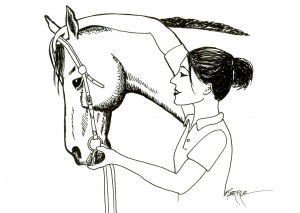 This is meant to be a horse training blog, but some readers really need a firm grasp of the basics before they are able to work with a horse, so I’d like to explain how to go about putting the bridle on a horse. This is a normal scenario of how things should happen, but I would always remind you that every horse is different, each will react in its own way.
This is meant to be a horse training blog, but some readers really need a firm grasp of the basics before they are able to work with a horse, so I’d like to explain how to go about putting the bridle on a horse. This is a normal scenario of how things should happen, but I would always remind you that every horse is different, each will react in its own way.
If your horse is difficult to bridle, chances are he experienced pain or discomfort somewhere along the way in his bridling, and will always resist it unless he learns to trust you to never hurt him again. Or it could be your horse just isn’t accustomed to wearing a bridle, and needs to practice getting the bridle on and off until it isn’t an issue anymore. Some horses are good to put the bridle on, but throw their heads up high and even rear when you go to take it off. These are all problems that stem from not bridling the horse the correct way, and the more you practice bridling the right way, the happier the horse will be during the bridling process.
The first thing to do is to train the horse to lower his head for you. You can teach him this with just a little practice. With a halter on, or just standing by his head if he is gentle enough to stay near you, put your arm along the top of his neck, so that your hand is just behind his ears at the top of his neck. Use a finger on each side of his bridle path to press down on the top of his neck. Keep a steady pressure (it doesn’t have to be hard–you aren’t pushing his head down forcefully, you are merely putting some pressure on him that will eventually become an irritation to him that causes him to move.) If he bobs his head or lowers it even a smidgen, instantly release the pressure and pat him and speak to him. You can then try it again. Just hold the pressure there until he gives. Once he learns that lowering his head results in a release of pressure, he will quickly lower his head when you place your arm along the top of his neck. I would suggest that you practice this each day or several times a day, and after a week or two, he will readily lower his head.
To put the bridle on your horse, stand at his left side and place your right arm along the top of his neck, the bridle in your left hand. Ask him to lower his head, and when he has his head lowered, transfer the top of the bridle to your right hand, which should be able to reach between his ears and hold the top of the headstall in front of his face, near his ears. Then with your left hand held out palm up, take the bit in your fingertips. Use the thumb of your left hand to hold the chin strap back from the bit. Your right arm can extend further between his ears to lower the bridle so that the bit hangs below his chin. The bridle will be on each side of his face, but not over his ears or in his mouth yet. Lift the bit in your left hand to his lips. Gently attempt to fit the bit between his lips. If he won’t open them, use the thumb of your left hand to slip in the corner of his mouth (there are no teeth there, so you won’t get bitten) and press down on the lower gums until he opens his mouth. Slip the bit in, while lifting the headstall up higher with your right hand, so that the bit stays in. After he has accepted the bit, it is easy to use both hands to slip the ears into place inside the headstall. Then fasten the throat latch (the strap that fits under the horse’s throat–some bridles don’t have them) and you’re ready to go.
Remember to be very patient and non-threatening in your movements. If your horse backs up or attempts to move away from you while bridling, move with him and try to keep the bridle hanging in place, with your arm along the top of the horse’s neck. Never get frustrated or show your impatience if things don’t work the first time. You want to make the experience as pleasant as possible, and you can always try again, and again. Gentle, consistent practice will help him submit to being bridled without fussing.
Once you get him the bridle on, feed him a handful of grain or a treat he really likes. Some people put molasses or honey on the bit, or try to hold grain in the hand they’re holding the bit in. This can help, but you run a risk of getting fingers bit, or teaching the horse to only accept a bit with honey on it.
To remove the bridle, always unfasten the throat latch first, then ask the horse to lower his head again, with your arm along the top of his neck. With your left hand, slip the headstall over his ears, and lift the bit out of his mouth. Sometimes a bit will painfully clank against a horse’s teeth when it drops out of his mouth, and this is what causes the horse to throw up his head when unbridling, because he is afraid it will hurt again. So you should be very careful to lift the bit over the horse’s lower teeth on its way out.
Just like with any horse training, the best way is to ask, wait for the action you want, and instantly reward the horse for doing the right thing.

